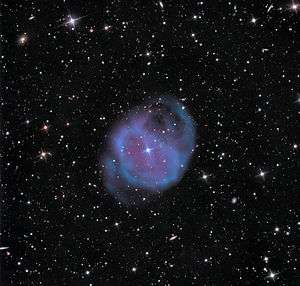Abell 36
| Nebula | |
|---|---|
 | |
| Observation data: J2000 epoch | |
| Right ascension | 13h 40m 41.34369s[1][2] |
| Declination | −19° 52′ 55.3200″[1][2] |
| Distance | 780 ly (240 pc)[3][4] ly |
| Apparent magnitude (V) | Integrated: 12.2–14.3;[5] Cental star: 15.4[2] |
| Apparent dimensions (V) | 6′.117 × 6′.117[1][2] |
| Constellation | Virgo |
| Physical characteristics | |
| Radius | 1.5 ly (0.46 pc)[3] ly |
| Notable features | A unique and detailed PN |
| Designations | PK 318+41.1, PN G 318.4+41.4 |
Abell 36 is a planetary nebula located 780 light years away in the constellation of Virgo.[3][5][6]
References
- 1 2 3 SIMBAD (4 August 2014), Results for PN A66 36, SIMBAD, Centre de Données Astronomiques de Strasbourg
- 1 2 3 4 "The Complete Abell Catalog of Planetary Nebulae". Astronomy Mall. Retrieved 2014-08-04.
MAG1 = Integrated VMag of PN / MAG2 = Mag of Central Star / SIZE = Diameter in arcminutes — ABELL:36 CON: VIR PNG# / OTHER: 318.4+41.4 MAG1: 11.8 MAG2: 11.5 SIZE: 6.2 RA: 13 40 41.3 DEC: -19 52 57 URA2: 149
- 1 2 3 Nemiroff, R.; Bonnell, J., eds. (30 May 2014). "Abell 36". Astronomy Picture of the Day. NASA.
The gorgeous, gaseous shroud of a dying sunlike star, planetary nebula Abell 36 lies a mere 800 light-years away in the constellation of Virgo. At that distance it spans over 1.5 light-years in this sharp telescopic view. Shrugging off its outer layers, the nebula's central star is contracting and becoming hotter, evolving towards a final white dwarf phase. In fact, in Abell 36, the central star is estimated to have a surface temperature of over 73,000 K, compared to the Sun's present 6,000 K temperature. As a result, the intensely hot star is much brighter in ultraviolet light, compared to its visual appearance here. The invisible ultraviolet light ionizes hydrogen and oxygen atoms in the nebula and ultimately powers the beautiful visible light glow.
- ↑ "Abell 36 Planetary Nebula in Virgo". Astrodon.
Abell 36 is a planetary nebula (PK 318+41.1) at RA 13h 41m 17s and DEC -19d 53m 10s in the constellation of Virgo. The field is 21' x 21' and north is to the upper left. The apparent size of the object is approximately 7.6' N-S and 4.8' E-W. It is estimated to be close at 780 light years distant with an age ranging from 4,700 to 8,000 years. The bright, central star in the image, FB138, is estimated to have an effective temperature of > 73,000 K. This image of the core was identified by Abell in 1966 from POSS plates. It is considered to have a bipolar structure.
- 1 2 Abell, George O. (April 1966), "Properties of Some Old Planetary Nebulae", Astrophysical Journal, 144: 259, Bibcode:1966ApJ...144..259A, doi:10.1086/148602
- ↑ Abell, George O. (1955), "Globular Clusters and Planetary Nebulae Discovered on the National Geographic Society-Palomar Observatory Sky Survey", Publications of the Astronomical Society of the Pacific, 67 (397): 258, Bibcode:1955PASP...67..258A, doi:10.1086/126815
External links
This article is issued from Wikipedia - version of the 9/27/2016. The text is available under the Creative Commons Attribution/Share Alike but additional terms may apply for the media files.